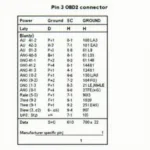Understanding how to clear engine lights OBD2 is crucial for any car owner. This guide provides a step-by-step approach to diagnosing and resolving those pesky check engine lights, empowering you to take control of your vehicle’s health. Let’s dive in and demystify the process of clearing those OBD2 codes.
Understanding the Check Engine Light
The check engine light, that often-dreaded yellow or orange glow on your dashboard, can signify a range of issues, from a loose gas cap to more serious engine problems. Ignoring it can lead to costly repairs down the line. The Check Engine Light is your car’s way of saying, “Hey, something’s not right.” It’s like a little canary in a coal mine for your vehicle. This guide will walk you through the how-to’s, but having the right scanner is essential, like the nt630 obd2 reader.
Why Does My Check Engine Light Turn On?
Several factors can trigger the check engine light. These include:
- Emissions System Issues: Problems with the catalytic converter, oxygen sensors, or evaporative emissions system.
- Ignition System Problems: Faulty spark plugs, ignition coils, or other ignition components.
- Fuel System Issues: A malfunctioning fuel pump, clogged fuel injectors, or a loose gas cap.
- Transmission Problems: Issues with the transmission control module or other transmission components.
How to Clear Engine Lights OBD2: Step-by-Step
Clearing engine lights OBD2 involves using a diagnostic scanner. Here’s a detailed walkthrough:
-
Locate the OBD2 Port: The OBD2 port is typically located under the driver’s side dashboard, near the steering wheel.
-
Connect the OBD2 Scanner: Plug your OBD2 scanner, such as the one found in torque obd2 howom, into the port.
-
Turn on the Ignition: Turn the key to the “on” position without starting the engine. This powers up the OBD2 system and allows the scanner to communicate with the vehicle’s computer.
-
Read the Diagnostic Trouble Codes (DTCs): Use the scanner to retrieve the DTCs stored in the vehicle’s computer. These codes indicate the specific problem areas.
-
Diagnose and Fix the Problem: Once you have the codes, research their meaning. This will help you pinpoint the root cause of the check engine light. Addressing the underlying issue is critical, not just clearing the code.
-
Clear the Codes: After fixing the problem, use the scanner’s “clear codes” function to erase the DTCs and turn off the check engine light.
What if the Light Returns?
If the check engine light comes back on after clearing the codes, it indicates the problem hasn’t been fully resolved. It’s important to get to the root of the problem. Sometimes a simple fix like tightening your gas cap, mentioned in the toyota tundra obd2 location article, can solve the issue.
Choosing the Right OBD2 Scanner
Selecting the appropriate OBD2 scanner is essential. Look for features such as real-time data streaming, code definitions, and compatibility with your vehicle. Real-time data is incredibly useful, as you can see in obd2 bluetooth real time. Options range from basic code readers to advanced professional-grade scanners.
“Investing in a reliable OBD2 scanner can save you time and money in the long run,” says automotive expert, Michael Stevenson, ASE Certified Master Technician. “It’s like having a personal mechanic in your pocket.”
Conclusion
Knowing how to clear engine lights OBD2 is an important skill for every car owner. This knowledge, combined with a reliable OBD2 scanner such as the proracing obd2 malaysia, empowers you to take proactive steps in maintaining your vehicle’s health and avoiding costly repairs. Remember, addressing the underlying issue is crucial, not just clearing the code itself.
FAQ
- Can I drive with the check engine light on? It’s generally not recommended to drive extensively with the check engine light illuminated.
- Will disconnecting the battery clear the codes? While disconnecting the battery might temporarily clear the codes, it’s not a reliable solution and won’t fix the underlying problem.
- How much does an OBD2 scanner cost? Prices range from affordable basic code readers to more expensive professional-grade scanners.
- Are all OBD2 scanners compatible with all cars? Most OBD2 scanners are compatible with vehicles manufactured after 1996 in the US.
- Can I clear engine lights OBD2 myself? Yes, with an OBD2 scanner and by following the steps outlined in this guide.
- Is it legal to clear engine lights OBD2? Clearing codes after fixing the issue is perfectly legal. However, clearing codes to mask a problem for emissions testing is illegal.
- What if my check engine light flashes? A flashing check engine light indicates a serious problem and requires immediate attention.
Common Scenarios for Check Engine Light
- Loose Gas Cap: One of the most frequent culprits. Ensure your gas cap is tightly secured.
- Faulty Oxygen Sensor: A crucial component for monitoring emissions. A failing oxygen sensor can affect fuel efficiency and emissions.
- Catalytic Converter Issues: The catalytic converter converts harmful exhaust gases into less harmful substances. A malfunctioning catalytic converter can lead to increased emissions and decreased performance.
Further Reading and Questions
For further information on OBD2 scanners and related topics, you can explore other articles on our website. Some common questions include “What is an OBD2 scanner?” and “How to use an OBD2 scanner.”
Contact us for assistance via WhatsApp: +1(641)206-8880, Email: [email protected] or visit our office at 789 Elm Street, San Francisco, CA 94102, USA. Our customer service team is available 24/7.
